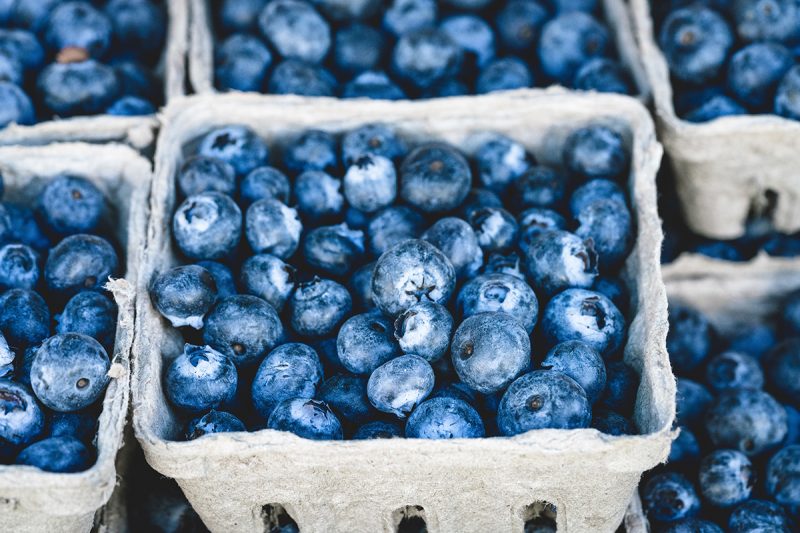
I’ll be honest. The first time I’ve heard about the zero waste movement, I didn’t know what that meant. Or rather, how that could be achieved.
In short, the zero waste movement aims to significantly reduce the trash we produce in our everyday lives. Several dedicated zero waste bloggers track their trash (anything that hasn’t been composted or recycled) in a jar to show how it’s possible to reduce our waste to that tiny amount.
Which, at first seemed a little too over the top for me, personally.
But, the more I read about it, the more I realized that:
+ It’s a great cause
I was actually shocked to read how much waste we create every day. Just a simple number: the EPA estimates the average American creates 4.4 pounds of trash/day, more than 250 million tons in a year. Only a third of that is recycled.
+ It’s not necessarily difficult to reduce waste
There are a lot of things we can do with some small lifestyle changes.
Why is waste reduction critical?
Producing waste is an unavoidable consequence of our lifestyle. But the how much and what matters a lot. These are only a couple of reasons why reducing waste is important:
+ Overflowing landfills are greatly contributing to global warming with huge greenhouse gas emissions.
+ Landfills also frequently contaminate the soil and water. This can affect all of us, but especially poorer neighborhoods where these are generally located.
+ You’ll see a great emphasis on reducing our plastic waste in these challenges. The reason is that plastic is not biodegradable, like wood, grass, or food waste. Plastic is pretty much indestructible and stays with us for hundreds if not thousands of years. Light breaks down plastic into tiny pieces – this mainly happens with the plastic waste in the ocean. Animals frequently eat it and die as a result or the tiny particles end up back in human food or on our shores.
+ Our natural resources are already very limited – we simply cannot afford to continue this use once/throw away/get another cycle.
There’s a ton of research and great tips and tricks on how to start this lifestyle. Since I was interested, I thought I would try a simple, practical thing: a 30-day zero waste challenge.
I didn’t actually stick to the rules of doing one thing per day (it doesn’t really make much sense to me), but I researched, tried or evaluated most of them over the course of a month.
So, let’s see, how that went (You can read the details of the actual zero waste challenges by clicking on the day titles). I hope by just reading about these, you can get a lot of ideas on what you can incorporate into your daily life as well.
The 30-day zero waste challenge: Lessons, successes, and fails
Day 1: Reusable bags //
Easy and simple, a lot of us do this already, right? Well, yes, if you don’t actually forget the reusable bags, which sometimes happens to me, I must confess. However, for the sake of this experiment, I was ruthless: no bag, no shopping.
To my utter astonishment, this actually worked. Anytime the thought of food shopping passed through my brain, the mental bell automatically rang: Take bags! Not once did I have to go without food for a night due to a lack of bags. I even went one step further and didn’t ask for plastic bags either in other shopping situations, like clothes or beauty. This one, I have to say, is easily manageable.
Day 2: Reusable water bottle //
I bought a pretty marble reusable water bottle a year ago. It’s been pretty much unused so far, but during this month, I did take it everywhere with me. I’m not sure though that I completely realized the actual goals of this task – I guess transferring water from a plastic bottle to a reusable one is not what the challenge had in mind. I took advantage of purified water tanks wherever possible, but as I currently don’t own a purifier, I was only able to reduce my plastic usage a little. However, when I move this year, I intend to set up a purifier so that we can drink tap water instead of bottled ones.
Day 3: Reduce fast food //
This one was an easy win for me as I haven’t eaten fast food in 6 years and I don’t plan to in the near future. But I’ve never thought about the waste perspective, even though fast food chains generate so much of it, from the boxes and wraps to plastic utensils, which we use for 30 minutes tops. So even if you’re not as drastic as me, try to reduce the fast food trips.
Day 4: Ditch the paper towels //
Part success. I mostly use kitchen rags for just wiping off the counter or wipe up water. I basically only use paper towels if something oily or greasy is involved and that’s very rare. So try to keep one kitchen rag nearby, it can be really handy.
Day 5: Coffee routine – bring your own mug or brew your own coffee //
Ok, so it was big news to me that the Starbucks and co. coffee cups are not reusable. Or, technically, they could be, but it requires such a sophisticated technique that basically no one does it now.
I guess this can be a pretty easy lifestyle switch. I have a great eco-friendly reusable coffee mug, but I also mostly drink coffee at home. Look around, there are great reusable mug alternatives online.
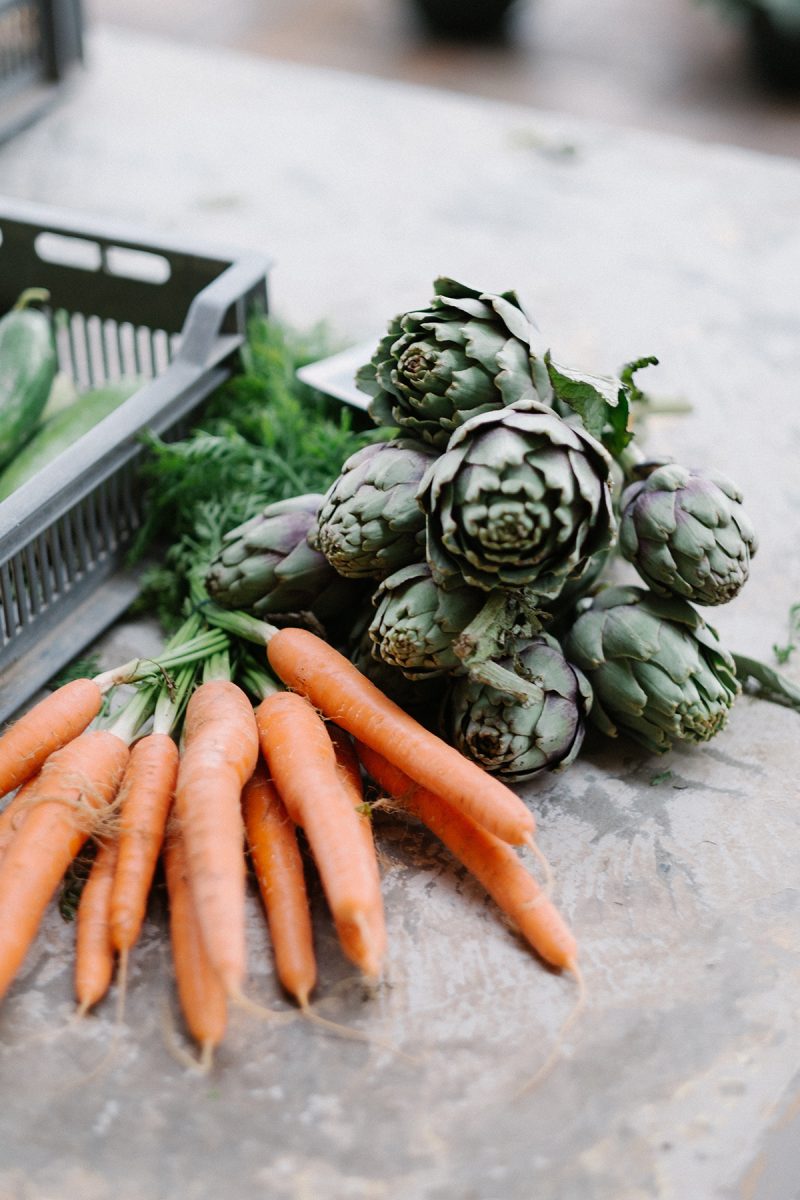
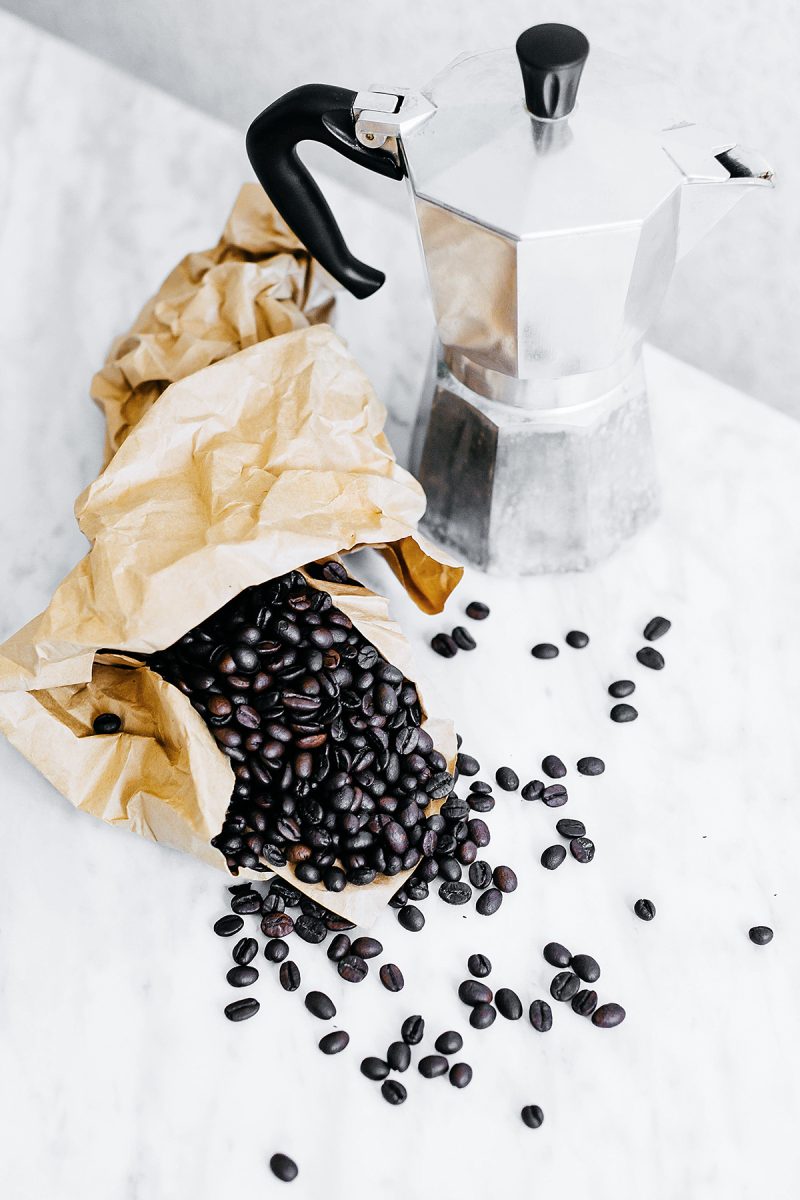
Day 6: Cloth produce bags //
This was another challenge that got me thinking about the unnecessary plastic bags. I haven’t invested in produce bags yet, but now I plan to. Whenever I can, I don’t put produce into plastic bags at all (like with fruits whose peels or skins we do not eat – melons, bananas etc) or I take my own. I’m not sure about softer fruits that can easily stain a bag though, like raspberries. Any suggestions?
Day 7: Bulk bins //
This is another great idea if you have access to bulk sections. Here, not a lot of stores do this yet, unfortunately, but I’ll be keeping an eye on this because for nuts or seeds I see this as easily doable.
Day 8: Reusable utensils //
Another one I’m kinda not guilty of. If I go out, I usually eat at a ‘normal’ restaurant, and of course, I don’t use plastic utensils at my office or at home. But it really doesn’t require much of an effort to have a small spoon or fork in your bag, especially as plastic ones are really wasteful – we usually use them only once and they may take centuries to break down, if at all.
Day 9: Returnable containers //
When I was a child, I remember there were options to take back and return empty glass bottles, but sadly not anymore. What I can do is take some bags and containers to the farmers market and use them instead of accepting their (mostly plastic) bags.
Day 10: To go containers //
No special opinion on this one. I don’t usually leave food in the restaurant (my leftover food lands with my fiancé usually), but if I take my lunch to work I use a glass container.
Day 11: Compostable toothbrush //
I didn’t have to replace my toothbrush during this time, and I wasn’t going to throw it away just for this, so no opinion on this one. But this intrigues me, so I probably will at least research some other options next time I need a toothbrush.
Day 12: Homemade toiletries //
Apart from a couple of products (like body or lip scrubs), I’m not a big fan of DIY beauty, so I didn’t try this one. I think you need a lot of knowledge and skills to make good and effective (and safe!! Preservatives are added to products for a reason!!) home-made beauty products and for now I have no inclination to go down that route. So, I sat this one out.
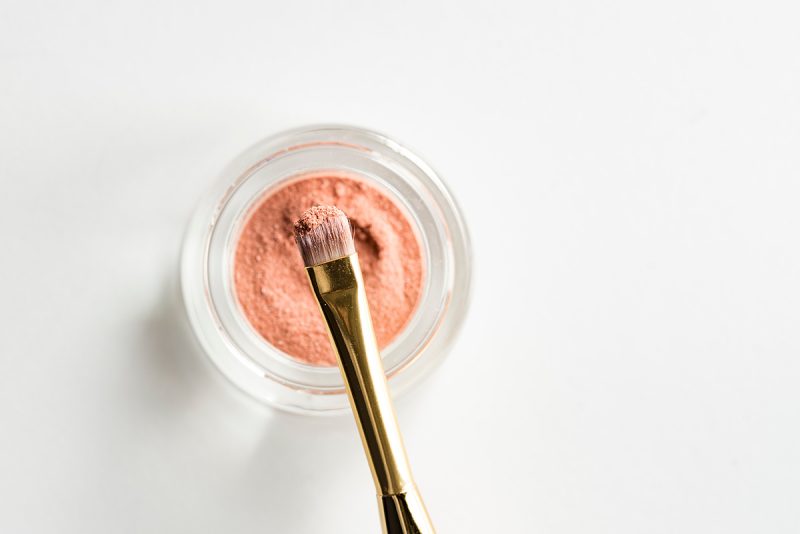
Day 13: Reusable menstrual products //
Well, I guess, this is where I personally draw the line. The cup solution simply doesn’t interest me (though I know there are fans out there), but the reusable cotton pads are just a big NO for me. Especially a DIY version. Also, I’m not sure the constant rewashing does very much good for the environment either. So, I confess, I haven’t even entertained the idea.
Day 14: Compost //
This one was useful because I learned a lot about what composting this. However, I currently do not have the means and the environment to do this, so this will go onto my ‘maybe one day list’ and for now, I’m sticking to recycling and selective waste collection.
Day 15: Farmers market //
I’m a big fan of farmers markets, so it didn’t take a lot of effort to complete this challenge. Luckily, we have one nearby, so we visit it regularly. I’m not saying we exclusively shop there, but for fruits, meat, vegetables, or honey we usually do.
Day 16: Junk mail //
I think this is more of a problem in other countries – I rarely receive any junk mail. However, instead of throwing them out, it’s way more effective to try to stop getting them altogether. Opt for e-bills and try one of these services to get rid of junk mail (this concerns the US, but I’m sure you can research similar services in any country).
Day 17: Soap //
A very tiny success with this one. I have a couple of artisan soaps without plastic packaging that I use, but this is another area that is a bit over the top for me. Making your own soap could be fun, but I’m not using apple cider vinegar on my hair, that’s for sure. The one time I tried olive oil (because of some raving reviews) was enough to deter me from experimenting for a lifetime. It took 6 additional shampoo washes to get the smell and the grease out of my hair. I pass on this one.
Day 18: Straws //
I get why this one can be frustrating. Along with the plastic utensils, this could be such an easy switch – not using them at all or opting for a reusable one. I rarely use straws, never at home, and in the future, I’ll try to remember to ask waiters to not put one in my drink if we go out.
Day 19: Opt for secondhand //
Reducing waste in fashion is a lot more complicated issue than I can go into in a few lines. I’m a big proponent of buying less and buying quality, but for me, it doesn’t necessarily mean ALWAYS second-hand. There are a lot of ethical brands or local designers that I’d gladly support by purchasing from them. But I’ll be honest, I wasn’t able to completely shut out less ethical brands for now – it’s still a journey for me. What I can definitely suggest is doing a lot of research on fast fashion, sustainable buying options, and even if you cannot do anything at once, start doing some smaller steps.
Day 20: Gifts //
To be honest, while I get that holidays have ramifications for waste production as well, this is not my first criteria when it comes to coming up with thoughtful gifts. I’m on board with buying experiences or giving home-made goods, and I tried using paper wrapping instead of plastic last Christmas. My approach is simply to give really meaningful/useful/unique gifts – not for the sake of giving, but finding something your loved ones really, really appreciate. It’s not about how much money we spend or how many gifts we give. And while I love giving gifts, holidays are so much more than that.

Day 21: Grow your own food //
I currently live in a 2nd-floor apartment in a city, so chances of me having my own little garden and animal farm on my balcony are relatively slim. However, I did start a cute little herb garden that I’ve been nurturing with great enthusiasm. And this is a great idea for everyone even without a balcony. Nothing better than using fresh mint for my lemonade or herbs for my salad. Thumbs up for this one.
Day 22: Safety razor //
Ok, this one caused some confusion in my life. A. I had no idea what a safety razor was (it’s not really a part of my active, non-native English vocabulary.) B. I’ve never looked at disposable razors as one-time only things. I actually use them for months until it goes dull while cleaning them thoroughly of course. After some googling, I think I now know what a safety razor is, though I must admit I haven’t invested in one. I don’t have the greatest skills when it comes to shaving, and it seems kind of a hassle now, so I put this on my ‘maybe one day’ list. For now, I’m sticking to the semi-disposable (changing only the heads) type of razors and trying to make them last as long as I can.
Day 23: Simplify your cleaning products //
So, here’s my thoughts and experiences with this. I’ve never given much thought to cleaning products before I moved to the US. But at the beginning of my stay there, after a very thorough cleaning and scrubbing session, I was shocked when I had some nose bleeding (sorry for the TMI). I never have it, and even though I cannot for certain say that some toxic material caused it, I don’t think that’s a coincidence. When it comes to the regulation of materials, there are great differences between the US and the EU – the latter being a lot stricter. This doesn’t mean that US products are all toxic; it can easily be due to the fact that I was just used to different chemicals, but I did switch to more natural products there. Some research can never hurt. However, with that said, I’m also a little bit wary of using only DIY products, just because I don’t have the skills and adequate chemical knowledge to mix and use everything with good conscience. I’m not sure that a very diluted vinegar/water mixture has the same anti-bacterial properties than a special cleansing product and to be honest, I’d rather not experiment with it. I also do not always know how certain materials (like ceramics or wood) can react to a home-made mixture. So I stick to the middle road here – using some cleaning products and use home-made solutions when I know they won’t cause any harm. For example, you can surely use vinegar for scaling – in kettles, on bathroom or kitchen metal surfaces. I’ve used them for years and it’s really effective. In this case, I’d say go with what you’re comfortable with.
Day 24: Eat more plants //
This is really easy. While I’m not a vegetarian, I don’t believe we must eat meat every single day – or multiple times a day. I go several days a week without meat, so this challenge was not very difficult. If you want to try this, designate a meatless day or make a challenge out of creating exciting meals without meat. Going to the local farmers market is also a great way to ensure the produce you’re eating is fresh. Buying locally and seasonally is the most important and probably the easiest thing we can do to support our health and the environment at the same time.
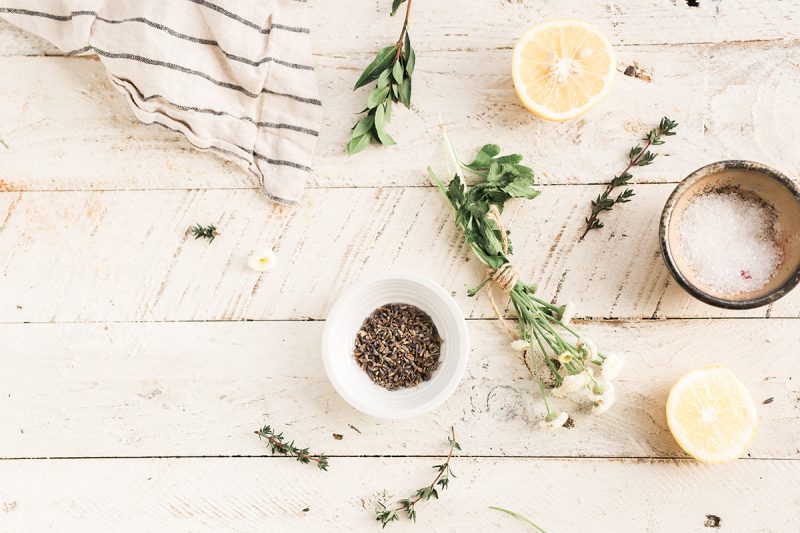
Day 25: Reusable tissues and hankies //
Another one, which is just over the line for me. No to DIY hankies and constant washing from me.
Day 26: Home efficiency //
I use LEDs, do not use air conditioning, do not overheat the room, unplug everything if we’re away. Collecting rainwater for watering plants was a new idea that I started – it’s really so easy and you still save some water. I also research methods to make our new flat more energy-saving (more on that later). Another important point: don’t just throw out old appliances – if they’re still working, you can donate them, if not – please recycle them, here’s how. In the last year, we donated our old refrigerator and took back old monitors to retailers – it’s truly simple and easy.
Day 27: Ditch plastic wrap //
For leftover food, I usually just put them in a glass container with a lid. Cookies and desserts go either in a container or I wrap them in the baking paper and a cloth. Get a couple of those glass boxes and you can get rid of a lot of plastic wraps as well.
Day 28: Repair and mend //
This fits nicely with my existing lifestyle. I’m a big believer in quality over quantity and do make efforts to repair stuff when needed. Try to take the time and make an effort to repair stuff instead of replacing them.
Day 29: Phase out plastic //
I definitely agree with the statement that we took advantage of the cheapness of plastic and really overuse it. If there’s one takeaway from this challenge it should definitely be a will to significantly reduce our plastic consumption.
Day 30: Recycle //
I try to recycle as much as I can. Read here and here about how you should recycle different materials.
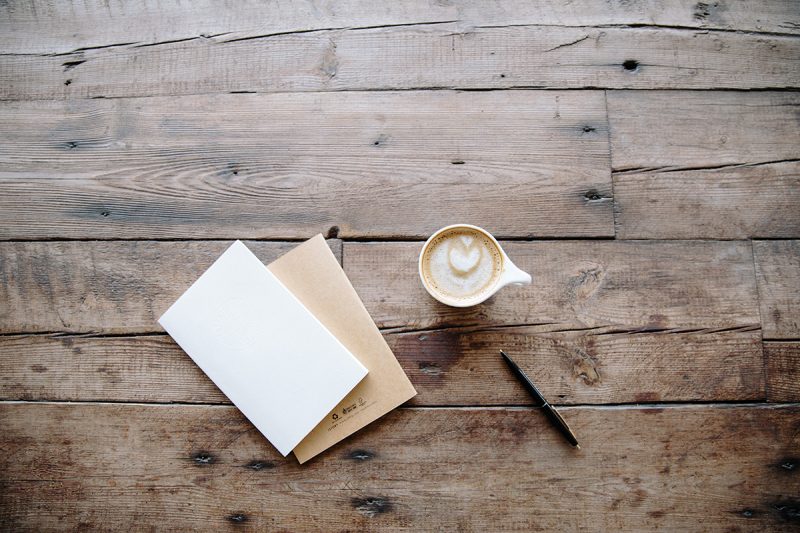
Life after the zero waste challenge
So, what’s the takeaway from the zero waste challenge?
First of all, while I did not complete all of the challenges, I did research on all of them. I gained a lot of important information and I feel I became a lot more knowledgeable about zero waste and sustainability. For that alone, I think it was worth it.
In my experience, it’s probably pretty difficult to go completely zero waste, however, it is relatively easy to significantly reduce the waste we accumulate.
Recycling, generally choosing reusable options over disposables, phasing out plastic, getting glass containers, buying seasonally and locally, buying reusable bags, and smarter shopping do not really require a lot of effort, but still can make a huge difference.
Some things I’ve been already doing, others were a new addition to my life. Some of them went on the maybe one day list, and I admit, some of them were a bit too much for me.
It’s all a question of habit and a little consciousness. As I said several times, it’s not an all or nothing game. If you can do some of them, great! Do that and don’t feel discouraged if you cannot tick off all the items.
Even small changes can make a huge difference.
If you’re interested in the zero waste lifestyle, check out all these expert bloggers:
SaveSave

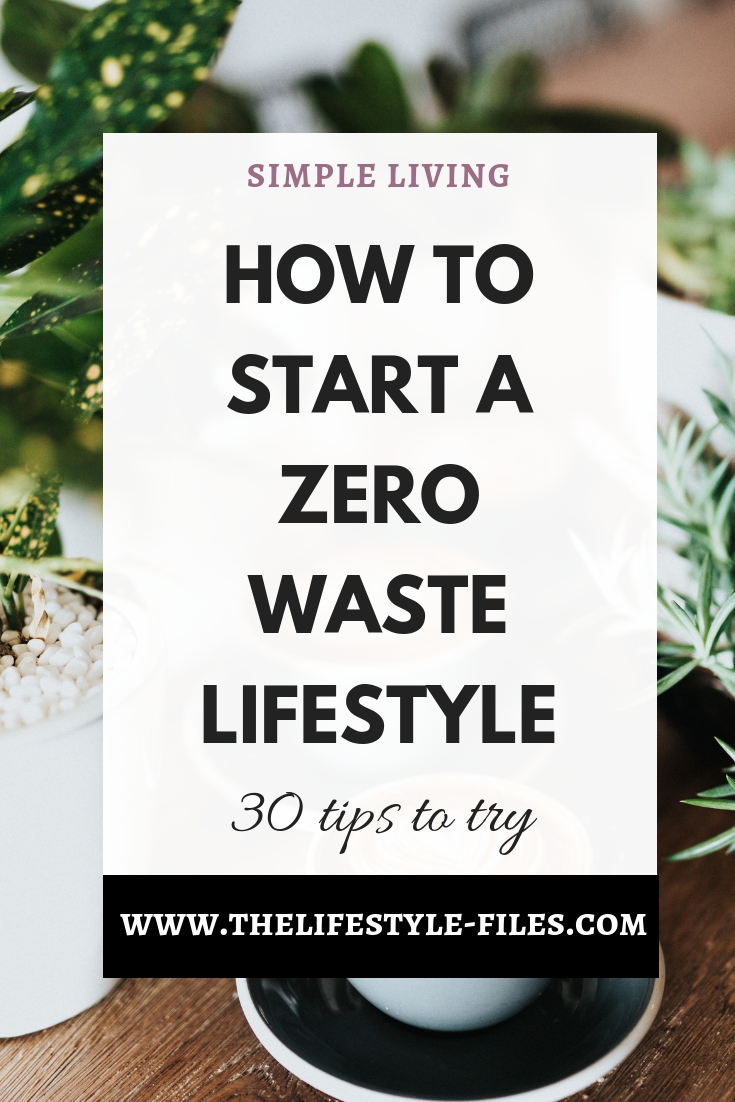
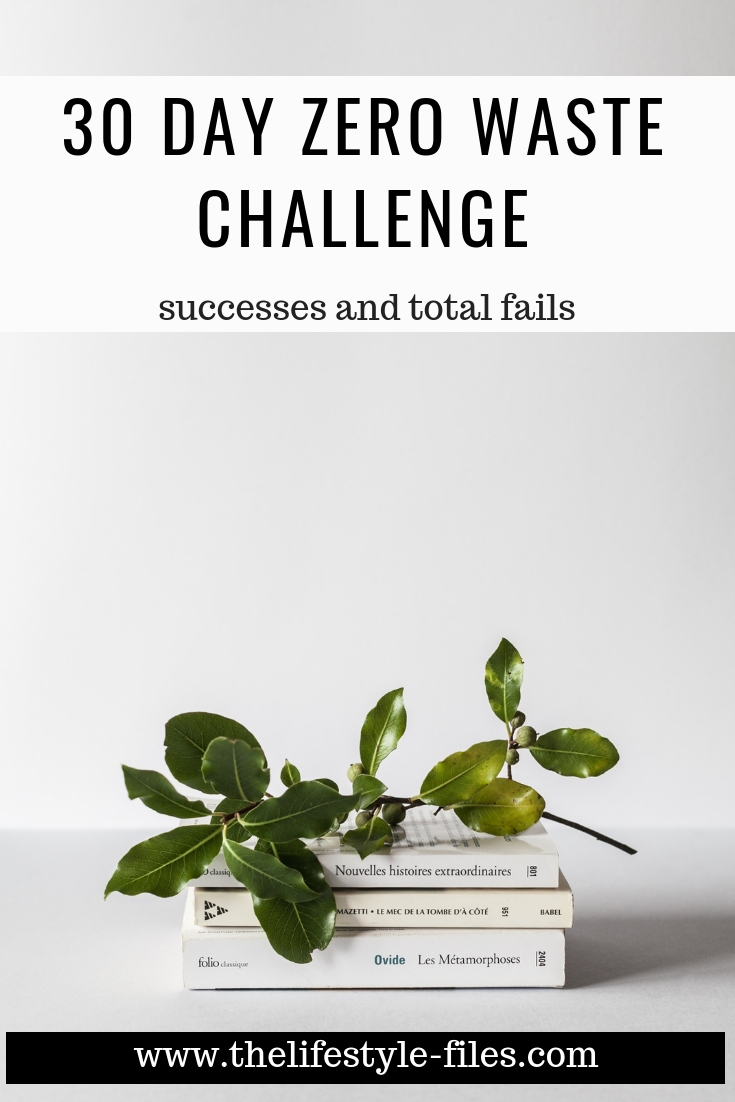
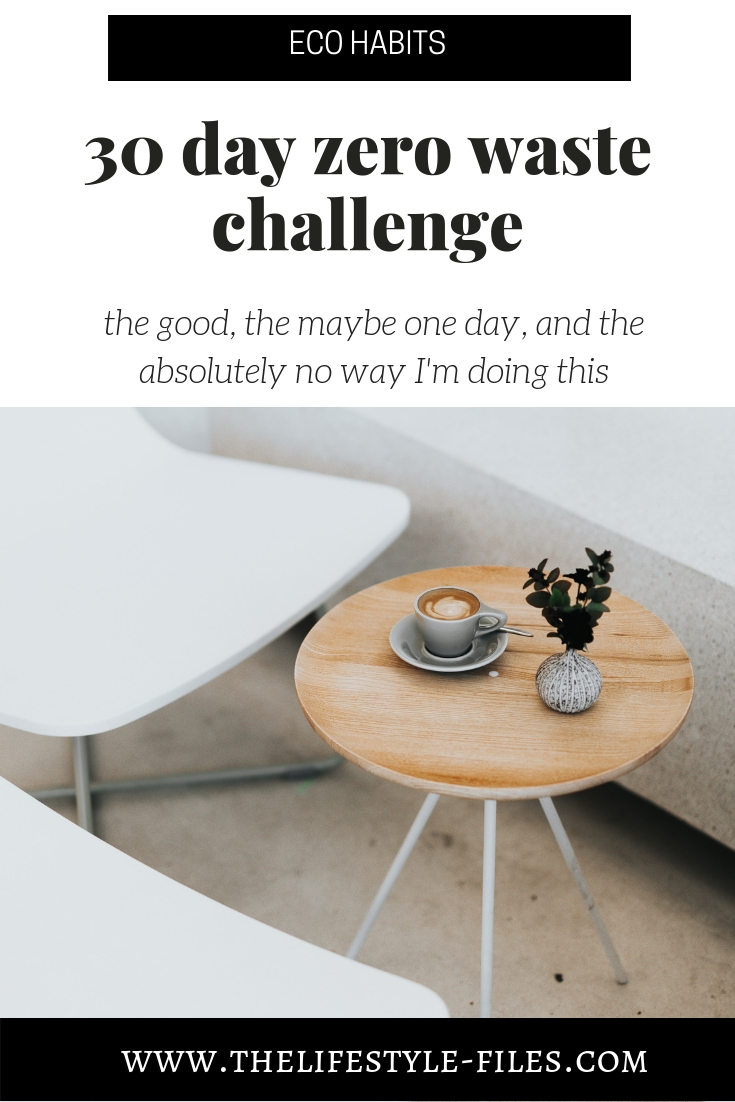
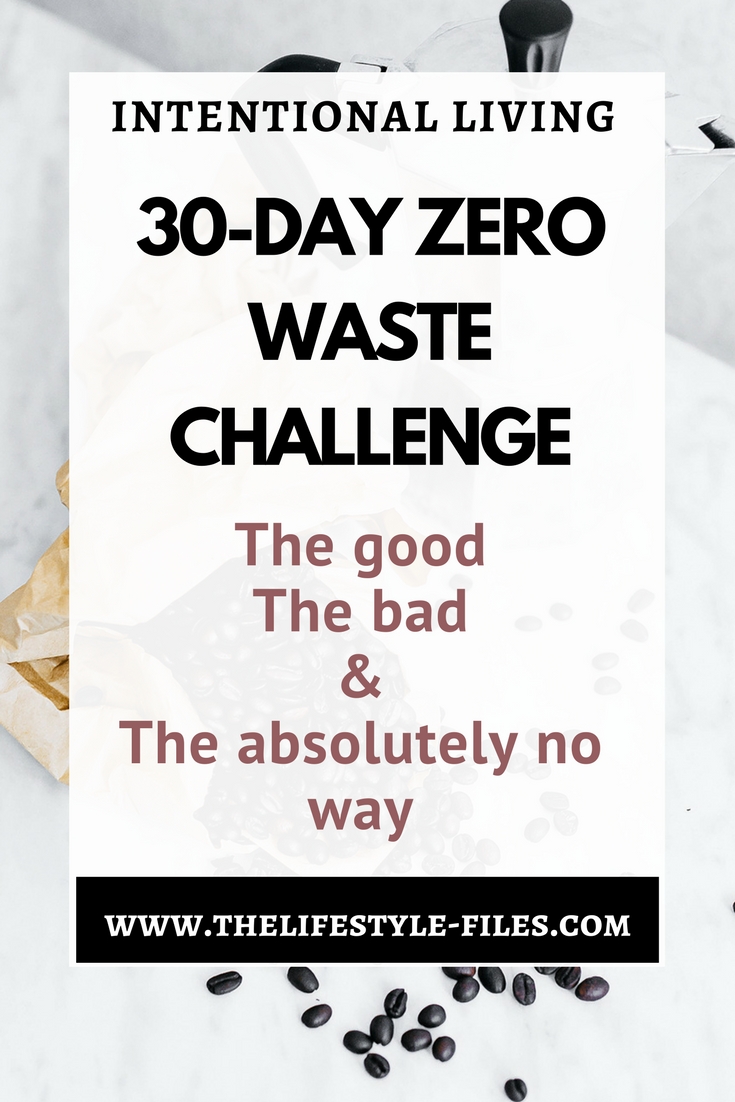
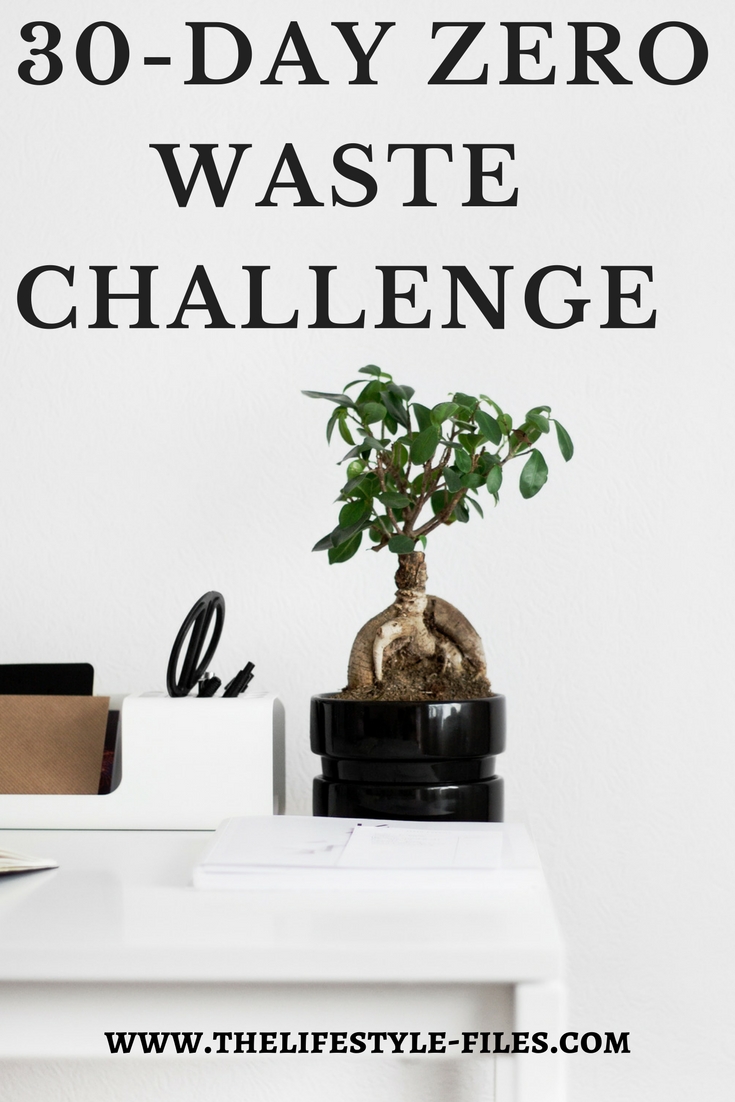
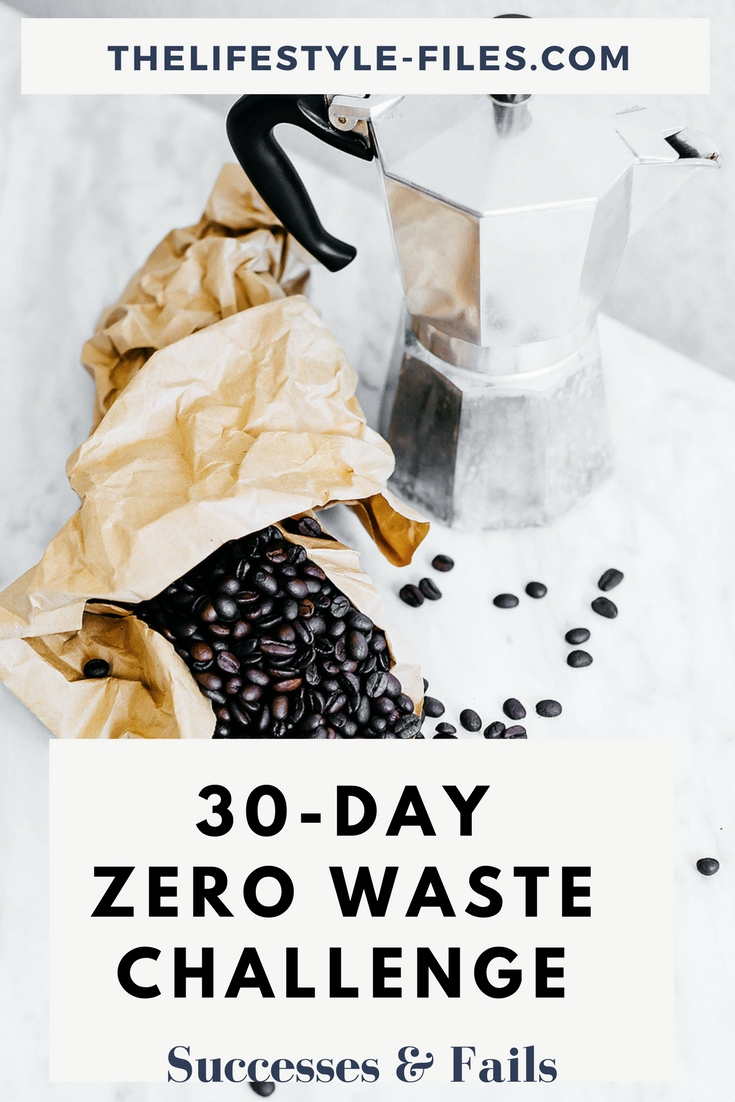
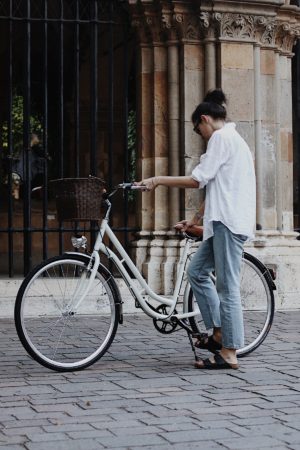
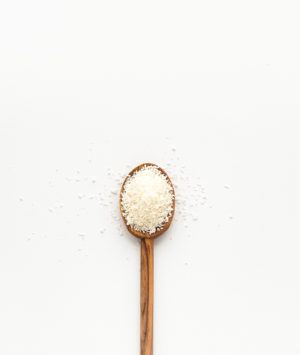
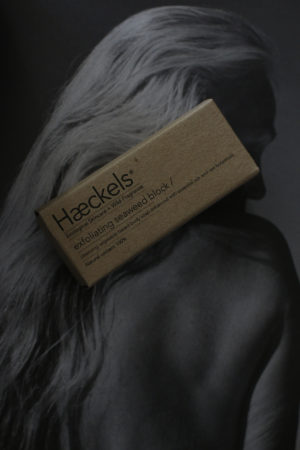
I love this! I too have been considering zero waste. Although being 100% zero waste seem unattainable to me at the moment, I am doing my best to eliminate unnecessary waste wherever possible. I love this challenge. But I tend to fall off challenge wagons pretty easily. However, I have been working on reducing waste in my own little way and it’s working. The global waste problem is actually a problem! Ugh.
I’m with you on the challenge front, I don’t particularly like them myself, that’s why I slightly adapted this – I experimented with the individual tasks a lot longer and also read a lot about the waste issue. And yes, I find it quite difficult to go totally zero waste, but every single small step counts and some of them are actually so easy to do. It makes me quite angry how much waste (especially plastic) we produce, so I’m trying my best to reduce at least my own footprint.
Yes, I’m all for educating as well – especially leading by example as you did. I agree that we should be talking about this more and more, especially because there are things we can do as well in our lives. I was also happy that a lot of these challenges I’ve already been doing, and they are really so simple and easy and don’t really require such a big lifestyle change.
i loved sitting down and reading this post. a lot of actions you don’t even think twice about are wasteful
Thanks for reading this mega-long post:) Yes, that was my biggest takeway as well, and changing these small things doesn’t even require a massive effort!